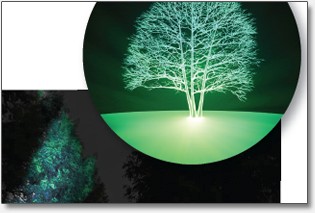Is Green Illumination on the Horizon?

By Colleen Salvatore
Bioluminescent Trees May Light the Way
We've all enjoyed evening strolls in the park with paths lit by street lights. Can you imagine a street or path illuminated not by street lights but by trees? This far-fetched fantasy may someday become a reality with genetically modified bioluminescent plants.
Nature's Nightlight
Dutch artist and innovator Daan Roosegaarde is combining his fascination with the luminescence of fireflies and jellyfish and the principles of biomimicry in the hopes of developing trees that actually glow in the dark and provide enough lighting to replace street lights. Roosegaarde explained, "When a jellyfish is deep, deep underwater it creates its own light. It does not have a battery or a solar panel or an energy bill. It does it completely autonomously."
His biomimicry quest led to a collaboration with Dr. Alexander Krichevsky, a biotech researcher from State University of New York, and founder of BIOGLOW™, a St. Louis-based biotechnology firm that developed the first light-producing plant. After several years of research, Krichevsky achieved a bioluminescence breakthrough when he spliced DNA from luminous marine bacteria within the chloroplast genome of a houseplant. The result was the Starlight Avatar™, the first autoluminescent ornamental plant.
More research is needed to make these plants commercially available given their two-to three month lifespan and intolerance to sunlight. The team will continue their work in the United States where it has received approval from the U.S. Department of Agriculture for the genetic engineering research. The European Union has strict regulations governing the use of genetically modified plants and this research work is prohibited.
Glowing Nature Paint
In a related bioluminescence project, Studio Roosegaarde is working on Glowing Nature, a noninvasive technique using 'biological paint' onto mature trees to create light-emitting foliage. The paint charges during the day and glows at night for up to 8 hours. Trial application of the material is scheduled to begin by the end of 2014.
Classroom Discussion
- What impact could glow-in-the-dark plant life have on living creatures?
- What other benefits could bioluminescent paint have on the environment?
- Could tinkering with the genes of plants have unintended consequences with native plant species?